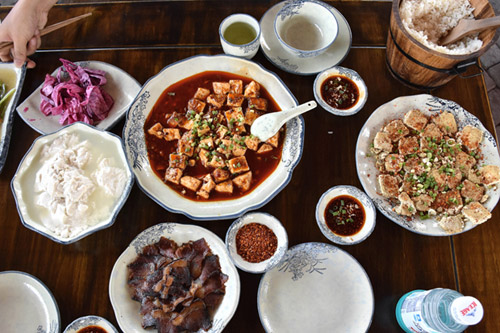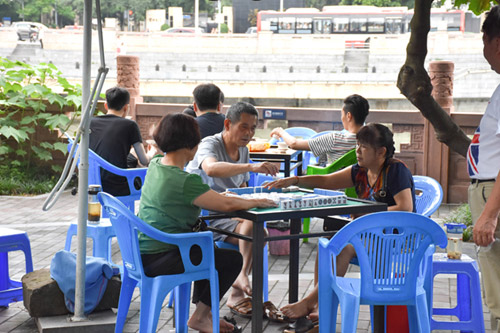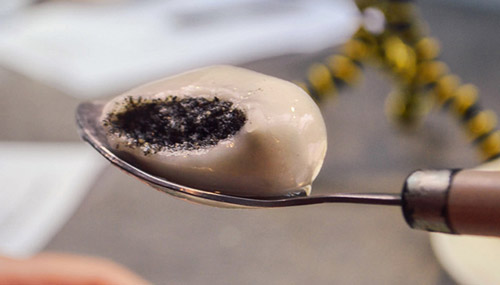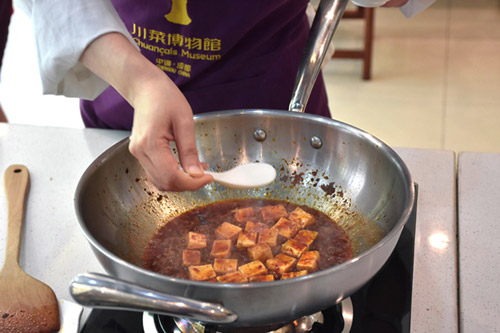East West Lifestyle
Recipes of China: Real Mapo Tofu From Sichuan
By Clarissa Wei

Food blogger Clarissa Wei uncovers the secret ingredient in truly authentic mapo tofu.
Of all the Chinese provinces I have visited in the last six months, Sichuan is my favorite. It’s a region that has captivated both my heart and my stomach. I must admit that my feelings toward this southwest province were already positive before I even stepped foot into it. I’m biased; my home city of Los Angeles is host to some of the best Sichuanese restaurants in the United States. I knew that it was the land of spice and peppercorns and that the locals take great pride in their food.
Sichuanese cuisine is unpretentious and it’s a huge contrast to the banquet-centric fare of the eastern seaboard cities of China. The best food comes in the form of “fly restaurants” — small, bare-bones nooks. The name refers to the constant buzz of the patrons. These places are specialists. Some do mung bean noodles drenched in vinegar and piquant spices; others specialize in pork wontons dressed in red oil.
Yes, the fare is often cooked with chili oil, tongue-numbing peppercorns and chili peppers, but contrary to stereotypes, it is not overwhelmingly spicy. The cuisine is, in fact, one of the most complex in the entire country. There are 56 different cooking methods and the food can be divided up into five basic flavor profiles: spicy, sour, sweet, salty, zesty. You will see wholesale spice markets with green and red peppercorns piled up sky high. Locally foraged Chinese ginseng is a testament to the region’s affinity for flavor.

What is most charming, though, is the region’s emphasis on leisure. City folks like to spend their off time at the homes of nearby farmers, where extra rooms are converted into casual bed and breakfasts. Tea houses are a common sight all throughout the city of Chengdu, the provincial capital. Old folks like to linger there with a cigarette in hand, immersed intently in a game of mahjong. Mahjong is played virtually everywhere in Chengdu: on the streets, in private homes, in public gardens. Although southwest China is not exempt from the stress of development and the fast-paced life that comes with modernization, the Sichuanese are adamant about taking things a little bit slower than their eastern seaboard counterparts. I love that. I feel much more relaxed here, and this is the first place in China where I can envision myself staying for a long period of time.

I culled the following recipe from the Museum of Sichuan Cuisine, a privately owned museum in a town called Pixian. Pixian is the home of the douban jiang — a chili bean paste that’s fermented and used in most of the dishes in town. It’s made from long skinny chili peppers (a variety called er jing tiao), kidney beans and salt, which are thrown into a large clay vessel and left there for years. These days, douban jiang is most commonly mass-produced in factories throughout Pixian but the Museum of Sichuan Cuisine has a dedicated space where they produce it the old-fashioned way: entirely by hand.

A high-quality douban jiang is an integral component of a good mapo tofu; it gives it intricate depth. In the United States, a simple chili bean paste from the local supermarket will have to do.
Sure, I’ll be the first to admit that mapo tofu is nothing new. It’s a rather famous dish and can even be found in Americanized Chinese restaurants in the United States. But a good Sichuanese mapo tofu is rare and one from a top-notch chef, properly made, will linger long after the plate is empty and licked clean. This rendition, I am happy to report, is proper. After all, it was designed by a museum dedicated to Sichuanese cooking. A good dash of Sichuan peppercorns at the end gives the dish its signature zest.
Here’s the recipe:

Mapo Tofu
Time: 30 minutes
Servings: 2
Ingredients:
- 1 1/2 cups of water
- 2 tsp salt
- 200 g plain soft tofu
- 5 g ginger
- 5 g garlic
- 1-2 baby leeks, cut into pieces
- Cooking oil
- 2 tsp chili bean paste
- 2 g fermented soybeans
- 2 g ground chilies
- Soy sauce
- 1 tbsp cornstarch
- Sichuan pepper powder, to taste
Directions:
- Heat 1 cup of water in a wok, turn a gas stove up to high, and stir in two teaspoons of salt.
- Cut the bean curd into cubes and put them in the wok with the hot salt water until boiling.
- Mince the ginger and garlic and cut the baby leeks into small sections.
- Remove the tofu and the water and put in a separate bowl. Wipe down the wok.
- Heat 1 tablespoon of oil in the wok, then turn the heat down to medium. Add 2 teaspoons of chili bean paste and stir-fry until the oil is a rich red color. Add in the fermented soybeans, ginger, garlic and ground chilies. Stir-fry 1 minute until the fragrance is apparent.
- Pour in 3 tablespoons of water and 1 teaspoon soy sauce in the wok and stir well. Place the tofu cubes (without the salted water) back into the wok and mix them gently in the sauce without breaking them.
- Meanwhile, combine 2 tablespoons of water with 1 tablespoon of cornstarch until the starch is dissolved.
- Add a pinch of the starch and water mixture into the wok. Wait for the wok contents to boil and then add another sprinkle. Then add the baby leeks, gently stirring them in. Finally, pour in the rest of the starch water, mixing well.
- When the soup has thickened enough to cling to the bean curds, turn off the stove. Serve in a bowl and sprinkle with ground Sichuan peppercorns to taste.
- From the Sichuan Cuisine Museum. Special thanks to Tibet Vista (www.tibettravel.org) for arranging the trip to the museum.


